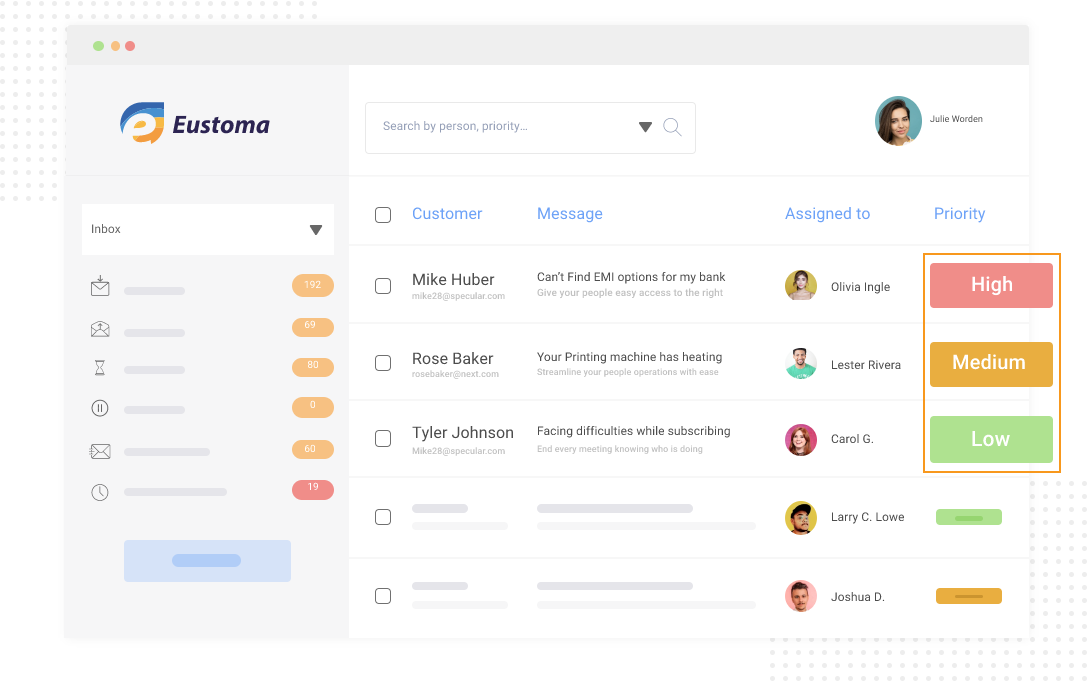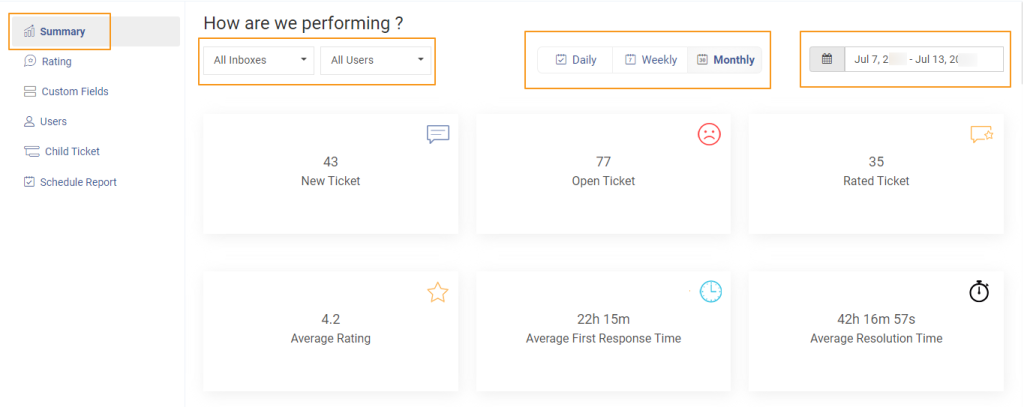But what is help desk software?
At its core, help desk software is the nerve center for managing customer inquiries and support requests. It is a must-have tool for everyone, from startups to Fortune 100s.
This makes it all the more important to understand the ins and outs of help desk software, including its benefits, functionality, and how it transforms customer service into a streamlined and rewarding experience.
Whether you’re a small business looking to improve support or a customer service manager wishing to gain more knowledge on this tool, this blog is for you.
What Is Help Desk Software?
Help desk software streamlines customer service operations by centralizing the management of customer queries and support requests.
It enhances efficiency through ticket management, automation, and self-service. It also integrates various communication channels to ensure comprehensive tracking of customer interactions. This tool is pivotal to help desk management, providing prompt and organized customer support.
Furthermore, help desk software offers analytics and reporting features that aid in evaluating service performance, leading to continual service improvement. It also facilitates internal collaboration, making it easier to handle complex issues and maintain consistent customer experiences.
What Are the Benefits of Help Desk Software?
From enhancing operational efficiency to deepening customer relationships, the benefits of implementing help desk software are extensive and impactful. Let’s discuss some of these benefits in detail –
1. Centralized Communication
By consolidating communications from various channels into a single platform, help desk software ensures that no customer interaction is missed.
This centralization makes it easier for support teams to manage and respond to queries, whether they come through email, live chat, social media, or phone calls. A unified communication hub helps maintain consistency in responses and provides a comprehensive view of customer interactions.
2. Enhanced Efficiency and Productivity
AI help desk management tools automate routine tasks like ticket sorting, routing, prioritization, and follow-ups, allowing support agents to concentrate on complex issue resolution.
Help desk software also reduces the chances of tickets slipping through the cracks, ensuring that every customer query is addressed. The centralization of communication channels simplifies the management of customer interactions, further boosting team productivity and efficiency.
3. Improved Customer Satisfaction
Help desk software streamlines the resolution process for customer issues, leading to faster response times and more effective problem-solving.
Read Opencart’s Success Story >
You can significantly enhance customer satisfaction levels by ensuring customers receive timely and accurate assistance. Features like automated responses and self-service portals provide immediate support, reducing frustration and demonstrating your commitment to high-quality service.
4. Data-Driven Insights
With built-in analytics and help desk reports, you can get insights into support operations and customer satisfaction. Businesses can track key performance indicators such as ticket response times, resolution times, customer feedback, and agent productivity.
These data-driven insights enable continuous improvement in service delivery, helping companies to identify trends, pinpoint bottlenecks, and make informed decisions to enhance customer support strategies.
5. Scalability
As businesses grow, so does the volume of customer support requests. Help desk software is scalable, allowing companies to add more agents easily, incorporate additional communication channels, and expand their support capabilities.
This flexibility ensures that the quality of customer service remains high, even as demand increases. Cloud-based solutions offer the flexibility to adjust resources and features as business needs evolve. If you’re switching systems, make sure to plan your help desk migration carefully to ensure a smooth transition with minimal disruption.
6. Knowledge Management and Self-Service
A robust help desk solution includes tools for creating and managing a knowledge base, which serves as a resource for customers seeking self-service options and agents needing quick information.
By enabling customers to find answers to common questions independently, the volume of support tickets can be significantly reduced. This not only enhances customer empowerment but also allows support teams to concentrate on more complex inquiries, optimizing resource allocation and reducing overall support costs.
What Are the Types of Help Desk Software
Help desk software can be categorized into several types based on different criteria, such as deployment method, functionality, and target users. Here’s an overview of the main types:
1. Web-Based or Cloud-Based Help Desk Software
A cloud-based help desk is hosted on the cloud by the service provider and can be accessed over the Internet. It’s popular for its ease of setup, scalability, and remote accessibility. Businesses opt for cloud-based solutions to avoid the costs and maintenance associated with on-premise hardware. Cloud-based help desk software can be accessed anytime, anywhere, enabling global teams to collaborate in real-time.
2. On-Premise Help Desk Software
Installed and run on the company’s own servers, an on-premise help desk gives businesses more control over their data. However, it requires a higher initial investment in hardware and IT resources. Also, there are constant worries about server maintenance, data security, backups, etc.
3. Enterprise Help Desk Software
Designed for large organizations, enterprise ticketing systems offer a broad range of advanced features, including asset management, network monitoring, and integration with ITIL (Information Technology Infrastructure Library) processes. It’s geared towards comprehensive IT service management rather than just handling customer queries.
4. Open-Source Help Desk Software
These are free to use and modify, offering a flexible option for companies willing to customize their help desk solution. While the software itself is free, implementing and maintaining an open-source solution can require significant technical expertise.
Who Can Use Help Desk Software?
Help desk software is a versatile tool used by various professionals to enhance customer support and service delivery. Here’s how different roles within an organization can utilize help desk software:
- IT Support Reps: These individuals use help desk software to manage and resolve technical issues reported by users or employees. The software helps them track tickets, prioritize issues based on urgency, and collaborate with team members to provide timely solutions.
- Customer Service Agents: Agents rely on help desk software to handle customer inquiries, complaints, and requests. The software allows them to receive, process, and respond to customer tickets through various channels like email, chat, and social media, ensuring no customer query goes unanswered.
- Customer Service Managers: Managers utilize help desk software to oversee the customer service team’s operations, monitor performance, and analyze metrics such as response times and customer satisfaction. The software provides them with the tools to manage help desk workflows, distribute workload among agents, and identify areas for improvement.

- Business Leaders: Executives and business owners use insights generated from help desk software to make strategic decisions about product improvements, customer service policies, and resource allocation. The software’s reporting and analytics features offer a comprehensive view of customer service performance and its impact on the overall business.
FREE. All Features. FOREVER!
Try our Forever FREE account with all premium features!
How Does Help Desk Software Work?
Help desk software streamlines and automates the process of handling customer inquiries and support requests. Its functionality can be broken down into several key steps:
Step 1: Ticket Creation
The process begins when a customer submits a query or issue through one of the multiple channels supported by the software, such as email, web forms, chat, or social media. The software automatically converts this query into a ticket, which serves as a unique record of the customer’s issue.
Step 2: Ticket Assignment and Routing
Once a ticket is created, the software can automatically assign it to the appropriate team or agent based on predefined rules, such as the issue’s nature, the customer’s location, or the agent’s expertise. This ensures that the right person is handling the issue from the start, improving resolution times.
Step 3: Prioritization and Escalation

Help desk software allows for the prioritization of tickets based on urgency, impact, or customer status. High-priority issues can be escalated to senior team members or specialized departments if they require more advanced expertise or immediate attention.
Step 4: Response and Resolution
Agents can respond directly to customer tickets through the software, which tracks all communication in a centralized location. This provides a full history of interactions that can be referenced throughout the resolution process. Agents can also access a knowledge base within the software to find solutions or use canned responses for common issues to speed up the response time.
Step 5: Collaboration
For complex issues that require input from multiple departments or experts, help desk software facilitates collaboration by allowing team members to share internal notes, insights, and updates within the ticket itself. This ensures everyone is on the same page and contributes to a quicker resolution.
Step 6: Resolution and Closure
Once the issue is resolved, the agent marks the ticket as resolved, and the customer is notified. Some systems automatically send a satisfaction survey to gather feedback on the support experience.
Step 7: Reporting and Analytics

Help desk software generates reports based on ticket data, including resolution times, agent performance, customer satisfaction levels, and common issues. These insights help managers and business leaders make informed decisions to improve service quality, adjust resource allocation, and identify areas for product or service enhancements.
How Does Investing in Help Desk Software Increase ROI?
Investing in the best help desk software for small businesses increases ROI by streamlining customer support operations, reducing response times, and enhancing customer satisfaction.
Automation of routine tasks and centralized communication reduce operational costs, while detailed analytics support continuous improvement and strategic decision-making. This combination leads to higher customer retention, increased sales opportunities, and improved efficiency, all contributing to a stronger bottom line.
Invest in the Best Help Desk Software Today!
Help desk software is a cornerstone technology for businesses aiming to elevate their customer support experience. Its diverse functionalities, from streamlining ticket management to facilitating insightful analytics, enable organizations of all sizes to deliver exceptional service.
For businesses looking to choose help desk software that can take their customer service to the next level, ProProfs Help Desk offers a robust, user-friendly solution that can transform support services. With its intuitive interface and powerful features like automated ticket routing, ticket prioritization, canned responses, etc., you can make every interaction count.
Try ProProfs Help Desk today and see the difference it can make in resolving customer issues and creating delighted customers who are your brand’s biggest advocates.
FREE. All Features. FOREVER!
Try our Forever FREE account with all premium features!
 We'd love your feedback!
We'd love your feedback! Thanks for your feedback!
Thanks for your feedback!





